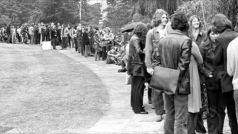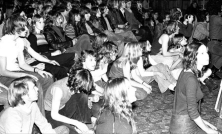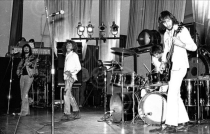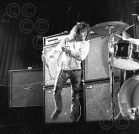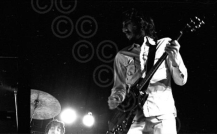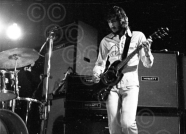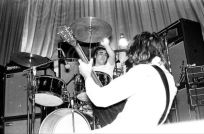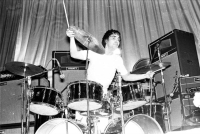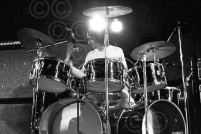The Who’s PA: 1971–1972
Early 1971, additional WEM column speaker cabinets bolster side-stage foldback.
On the 1971 U.S. tour, Hiwatt foldback behind the drumkit appears, along with a switch to Sunn bins for side-stage foldback. In addition, the guitar and bass “monitoring” at each side of the backline beings using a full “stack” placed at each side of the stage to monitor each other’s instruments — a bass stack (Sunn) at stage left next to Pete’s four Hiwatt cabinets, and a Hiwatt stack and amp at stage right next to John’s rig.
In addition, Keith began using headphones on stage in 1971 for certain numbers, which he taped to his head with gaffertape, so he could hear the backing tape for Baba O’Riley and Won’t Get Fooled Again.
As the 1971 U.S. tour progressed, the Who ceased using the WEM PA, which became problematic for larger halls. Bob Pridden contacted Sunn and was subsequently connected with Bob Heil, of Marissa, Illinois, who had designed the Sunn Coliseum Series PA and was one of America’s largest dealers of Sunn equipment. Heil had a PA flown from the Sunn factory in Tualatin, Oregon, to Boston. On Aug. 7, 1971, the Who debuted the new Sunn PA.
Selected quotes
All quotes and references are copyright their original owners and are included for reference only.
Roger (from the Concert File): “We spent all day today trying to sort out the problems we had last night and we’ll probably spend all day tonight sorting out for tomorrow evening. We’re using a new sound system … it sounds all right up here. How’s it sound out there, all right?”
From May 2006 EQ Magazine interview with Bob Heil:
“The next thing you know everybody was calling us, and that’s really how it all started. They needed to fill these auditoriums with sound, and we were the only ones who really knew how to do it. From there The Who contacted us. They were out playing through these dinky little columns and they were sounding terrible; so they contacted us and we got in behind Who’s Next. This started the whole revolution, not just Heil sound, but the entire sound revolution.”
From May 2006 Musician’s Friend article Bob Heil: A Living Live-Sound Legend interview:
- MF: How did you get involved with The Who?
BH: They hadn’t been here in several years; since the late ’60s. During that time, the level of concert sound quality came way up. They came over here with their little columns, like VocalMasters, if you remember what those were. Just little columns with four speakers in them. They had about six of these across the front of the stage. Think about that. Think about that. The Who playing through these little mixers with eight channels on them, and these little columns. The guitar amp was louder than that!
They came over (to the US) to do this huge tour, Who’s Next, and they miserably bombed the first night. It was terrible. So their manager had heard about this sound system. We were working with Sunn — I was their largest dealer — and I was doing design work for them. We had just put together this monster system for Sunn. We hand-built this console, all point-to-point wiring.
So we were on tour with Wild Cherry in Chicago. The Who’s people called Sunn because they’d heard about me and this sound system.
Sunn called me and said, “You have to get to Boston.”
I said, “Yeah, OK. When?”
“Tomorrow.”
I said, “Well, I’m on tour.”
They said, “We don’t care, we want you to get there.”They told me to rent an airplane if I had to. So we did, we rented a Tiger 707! Tiger was an air freight company back in those days in Chicago. I called a buddy of mine to come finish the Wild Cherry tour, and we flew all that stuff out to Boston. We set it up for soundcheck and blew them (The Who) out on the street. They’d never heard anything like it, and it changed the whole direction of The Who. Townshend was freaking out because they’d never heard anything that good, that loud, that big.
We did two complete tours, I think 36 dates each, then we went to England and toured over there. We played for about 200,000 kids in a cricket oval! From there we did some European dates, then came back here for more American dates with Who’s Next.
From December 2008 Performing Musician interview with Bob Heil:
Bob Heil continued to improve his sound system. He built a second crossover out of the console, giving the system stereo capability, and used fibreglass instead of wood for low-frequency cabinets to reduce resonance. His next try at a live sound FOH mixing console would help to design the Sunn Coliseum, a Vocalmaster on steroids that gave large clubs, small theatres and local touring bands a tool that vastly expanded what music could sound like and how much space it could fill. He built more systems, both renting them out and selling them. What was now Heil Sound ventured with UK-based IES Systems, who had developed the Mavis mixer, which Heil describes as the first truly modern FOH desk with a modular circuitry design and external power supply. “It was an amazing console, though only four were ever made — they weighed 300lbs each!” he says. The two companies standardised key interfaces of their systems, such as speaker connectors, so they could use each other’s gear on opposite continents.
From 2015 Sound on Sound interview with Bob Pridden:
In 1969, the Who moved over to WEM [Watkins Electric Music] PA systems, comprising varying numbers of WEM speaker columns and a WEM Audiomaster mixing desk. But, as Bob Pridden explained, with the group gigging at increasingly larger venues, including huge open-air festivals such as the 1969 and 1970 Isle Of Wight events, the WEM system no longer fulfilled the Who’s ambitious sonic requirements.
“The WEM system just outgrew itself,” says Bob. “We ended up with about two or three thousand Watts of WEM stuff which we used at the Isle Of Wight festival, and then we bumped that up with Pink Floyd’s WEM system to make it even bigger but, really, with that stuff, for every 1000 Watts, you only get about a couple of extra dB, so it really didn’t cover big gigs like that. In those days everyone suffered with that problem. The second Isle Of Wight [1970] was just so big and that’s when you needed to get something with horns in it to project the sound. The WEM system was great at smaller venues because it was a big hi-fi system, but when you started playing to crowds of, like, 50,000, 100,000 or whatever, it just didn’t work.”
Funnily enough, Bob Pridden had actually glimpsed a way forward for the Who’s live sound a few years prior to the Isle Of Wight performances. It was during an early tour of the USA: “We were doing the Murray The K show in New York in 1967 or ’68, I think it was,” explains Pridden. “A band called the Young Rascals brought their own PA in and they had horns and bass bins. I looked at it and thought, ‘This is the way forward!’ That was really one of the first times that I saw a system with horns and Altec’s the Voice of the Theatre system. That’s what they had for the sound in cinemas. They were pretty basic, with Altec mixers, but the idea was great and they really threw the sound.”
During the band’s 1971 US tour, the Who started playing through a mammoth new PA system built by Sunn and US gear guru Bob Heil. “Bob Heil and Sunn built that together and especially for us,” says Bob. “That happened just by Bob Heil being introduced to me by someone, and then we all got together and they built a JBL system, but it was all enclosed in Sunn cabinets. It had two-way crossovers and horns with 2440 drivers — probably four horns a side and eight bass bins a side — and 15-inch loaded cabinets. What I hadn’t liked about the JBL Altec system was that the sound was very harsh, but this one was really great. The first time we used that system in America, it was sensational! It was really the first time people had heard decent stuff with horns! We brought it back to England with us and we played the Oval cricket ground in South London [18th September 1971, other acts included the Faces and Mott The Hoople] and used it there. Of course, everyone else used another system but, when it was our turn, we switched ours on and it was just unbelievable! Later on, they came out with a Sunn mixer, which took the place of the old WEM Audiomaster. I can’t remember how many channels they had but we had two of them and we had sends for the echo and we used to mix the monitors from there as well.”
From 2015 Sound on Sound interview with Bob Pridden:
In 1969, the Who moved over to WEM [Watkins Electric Music] PA systems, comprising varying numbers of WEM speaker columns and a WEM Audiomaster mixing desk. But, as Bob Pridden explained, with the group gigging at increasingly larger venues, including huge open-air festivals such as the 1969 and 1970 Isle Of Wight events, the WEM system no longer fulfilled the Who’s ambitious sonic requirements.
“The WEM system just outgrew itself,” says Bob. “We ended up with about two or three thousand Watts of WEM stuff which we used at the Isle Of Wight festival, and then we bumped that up with Pink Floyd’s WEM system to make it even bigger but, really, with that stuff, for every 1000 Watts, you only get about a couple of extra dB, so it really didn’t cover big gigs like that. In those days everyone suffered with that problem. The second Isle Of Wight [1970] was just so big and that’s when you needed to get something with horns in it to project the sound. The WEM system was great at smaller venues because it was a big hi-fi system, but when you started playing to crowds of, like, 50,000, 100,000 or whatever, it just didn’t work.”
Funnily enough, Bob Pridden had actually glimpsed a way forward for the Who’s live sound a few years prior to the Isle Of Wight performances. It was during an early tour of the USA: “We were doing the Murray The K show in New York in 1967 or ’68, I think it was,” explains Pridden. “A band called the Young Rascals brought their own PA in and they had horns and bass bins. I looked at it and thought, ‘This is the way forward!’ That was really one of the first times that I saw a system with horns and Altec’s the Voice of the Theatre system. That’s what they had for the sound in cinemas. They were pretty basic, with Altec mixers, but the idea was great and they really threw the sound.”
During the band’s 1971 US tour, the Who started playing through a mammoth new PA system built by Sunn and US gear guru Bob Heil. “Bob Heil and Sunn built that together and especially for us,” says Bob. “That happened just by Bob Heil being introduced to me by someone, and then we all got together and they built a JBL system, but it was all enclosed in Sunn cabinets. It had two-way crossovers and horns with 2440 drivers — probably four horns a side and eight bass bins a side — and 15-inch loaded cabinets. What I hadn’t liked about the JBL Altec system was that the sound was very harsh, but this one was really great. The first time we used that system in America, it was sensational! It was really the first time people had heard decent stuff with horns! We brought it back to England with us and we played the Oval cricket ground in South London [18th September 1971, other acts included the Faces and Mott The Hoople] and used it there. Of course, everyone else used another system but, when it was our turn, we switched ours on and it was just unbelievable! Later on, they came out with a Sunn mixer, which took the place of the old WEM Audiomaster. I can’t remember how many channels they had but we had two of them and we had sends for the echo and we used to mix the monitors from there as well.”
From 1971 Billboard interview with Pete Rudge, the Who’s tour manager:
Home on the road for the equipment is a specially designed 40-foot-long truck with a long wheelbase.
After the release of their rock-opera “Tommy,” the Who’s demand and audience became so large that bigger concert halls and auditoriums were needed. Pet[e] Rudge, president of the Who’s Track International who is in charge of the group’s touring dates in the U.S., notes: “Before ‘Tommy’ we’d always played conventional halls, around 3,000 capacity, where the sound could, to a certain extent, be controlled. But about a year ago, the Who saw the strength of their audience in America and were persuaded to go for the bigger places, both indoor and outdoor. Outdoor gigs with the Who have always been difficult—they don’t really like to do gigs like this because of the trouble getting the sound down pat.
“But for the U.S. tours especially, Pete Townshend and Bob Pridden, who is our kind of super roadie and the fifth Who, have thought up a set of equipment that takes care of all our troubles—a kind of stereo P.A. system that can be subjected to all the stresses and strains of being carted around the country. It has something like a 75-foot lead so you can put speakers at the back of the hall or whatever and get exactly the same sound coming from the stage.”
The Who’s ideas were developed to reality by Charlie Watkins of the WEM organization in the U.K., which was discovered by one of the roadies four years ago.
The Who travel big: 10 extra people around to make sure they stage and sound perfect. Four come from England including Pridden, who is the only road manager who has his own chauffer (“Superstar?” says Rudge) and doesn’t travel with the equipment. And there is John Wolfe [Wolff], who like Pridden, has been with the Who for six years. Pridden and Wolfe are Townshend discoveries and they also work with the group when they are in the recording studios.
It is essential they arrive early. The advance party go into the city the night before the actual concert and get to the auditorium at 8 a.m. This is is when the truck is driven over and the road team—the last tour Rudge hired four extra men because of the equipment volume—start work. Rudge maintains it takes 12 hours to get the Who set up properly because the Who travel with their own lighting system. “We carry around 50 lights and each one has to be put up individually—rather like traveling with a circus,” says Rudge.
During a concert Pridden works the sound mixer board, prompting him to say: “It’s not just a question of twisting a dial, flicking a switch. These people are part of the performance. Townshend is likely to switch things around on stage and you have to be ready for this. That’s why roadies are called members of the group.”
For the band’s new numbers with pre-recorded organ/synthesiser, the tape recording was fed through the PA.
From 2015 Sound on Sound interview with Bob Pridden:
Back in the early 1970s, the Who were not only one of the globe’s most pioneering groups in terms of PA size, quality of live sound and the development of on-stage monitor systems, they were also using live tape playbacks before most other rock & roll bands on the circuit. Yet again, Bob Pridden was central to making this happen, while he was also the man with his finger on the buttons!
The Who pioneered the use of multitrack playback systems on stage, starting off with four-track tape machines, but now using a 24-track digital system.
“We started off using tape playback probably around the time of Who’s Next [1971], but it was very archaic,” remembers Bob. “We were one of the first bands to do it although I think Pink Floyd started to do it not so long after us. We started off using Revoxes but then we decided we wanted to split the tracks up so we got some Sony quarter-inch four-track recorders and used those for a while. But we started getting a few problems and I felt we needed a bit more so we got half-inch four-track Scullys on stage, which were fantastic! The thing is we only had one in those days and, of course, when they were doing a set, all of the backing tracks were on one reel and so if they changed the set around, I had to spool back and spool forward — that could be a nightmare! By the ’89 tour, I just got so fed up with it that I got three TEAC four-tracks and I got a switcher box made. Each track was on its own reel so I could have four different songs up at a time and switch between them if they changed their minds, or change one while another one was running. Later, we changed to Fostex eight-tracks.
The first Heil/Sunn PA comprised:
- 16 JBL model 2440 wide-ranging compression drivers, each attached to a fibreglass radial horn.
- 16 front-loaded 1×15″ cabinets.
- 8 1×18″ woofers.
- 16 Sunn 300-watt RMS power amps.
Onstage monitors:
- 8 radial horn and driver combos
- 12 1×15″ bottoms
- 6 Crown 300-watt RMS power amps
Mixing boards (stage-left, run by Bob Pridden):
- Two custom-designed Mavis 15-channel mixer/control boards, one for the drums, one for the rest.
Pre-recorded tape playback (for Baba O’Riley and Won’t Get Fooled Again)
- Two Revox tape decks
John Entwistle also began using the first iteration of his Sunn rig at this time, a 1,200-watt system, also designed by Bob Heil. It was not miked through the PA.
The Sunn PA was used through August 1971. By October 1971, Heil created Heil Sound, a manufacturing enterprise, along with his PA rental and retail business. A £20,000 Heil-built PA was used for the remainder of 1971, beginning with the Oval Cricket Ground, Kennington, South London, show on 18 September 1971.
The second Heil PA featured:
- 32 front-loaded bass cabinets each with one JBL 2205 15″ speaker
- 32 radial horns with 2482 drivers.
- 6 radial horns with 2420 super high-compression drivers
- 4 mid- to high-frequency long-throw horns with JBL 2440 drivers.
- 32 JBL 2405 high-frequency tweeters.
- 12 Crown DC-300A 300-watt power amps.
Foldback, mixing desks and tape decks same as above.
The Who would continue working with Heil until 1975, when Heil retired from the PA rental business to concentrate on manufacturing.
From May 2006 EQ Magazine interview with Bob Heil:
“We got into the monitor thing out of necessity,” Bob says. “Pete Townshend and Roger Daltrey really needed all this to happen, so we built them some massive systems. We started putting fiberglass in the speaker cabinets, because it wouldn’t resonate like plywood or the other materials people were using. We wanted a really dense material to work with, and that’s why we chose fiberglass — it gave us an edge up on the speakers themselves. But we had to do it in a big way. I remember when we did Madison Square Garden with Quadrophenia. We had more stuff on just the stage than most people had in their entire PA. It was enormous. I think we had, on each side, 6–8 15 bins, 6–8 radio horns, and probably about a dozen tweeters; we could get about 110–115dB on that stage before feedback. And The Who loved it, of course, because it was loud. And they were loud, if not the loudest.”
The feat of amassing a system of monitors had been overcome years before, but there were problems still plaguing the team, and the entire world of sound in general, as Bob remembers. “The monitor was always the big problem. Nobody had really been able to make the monitor work before: They fed back all the time. You would have a mic about three feet from the monitor while these guys were playing louder and louder; and the next thing you knew it was total feedback city, and it seemed like nobody could get it all happening the way it really needed to happen.”
The key, as Bob had learned much earlier on, lay in the realm of phasing. “Back in my ham radio days, around 1960, I had put up a monster antennae; 4 feet by 40 feet and hoisted 50 feet in the air. It was a monster antennae of 128 elements; different elements that all had to be phased. So I learned about phasing monitors through phasing antennae.” Little did Bob know that in 1960, playing with radio frequency, that something would occur that would change his, and our, lives not much later down the road.
“I had brought in these monitors and started thinking ‘wait a minute I can start playing with phasing’ . . . and I did. We would run the microphones out of phase from the monitors, something that nobody had been doing yet. Since they were out of phase from the mics and the front systems, we could get these things incredibly loud before they would feedback.” The key to the golden lock was phasing, as Bob relays to everyone he instructs. “That’s one of the things that Jerry Garcia was really in love with. Our monitors were really something; and we got those guys into doing all kinds of phasing tricks with the monitors and mics. As you know, a lack of phasing equals no sound; so it’s all very important — the placement of monitors, the types of microphones, and having it in the right phase or the wrong phase.”
Courtesy the Concert File: Southampton Evening Echo 19 October regarding the 19 October Guild Hall, Southampton, gig:
“The Who must be regarded as the most exciting and loudest rock group in the world after attempting to pulverise the sound barrier in Southampton Guildhall last night. So intense was the noise that many of the 1,600 fans who swarmed into the hall had splitting headaches and numb or aching ears. During the two-hour performance the volume was so great from elaborate equipment worth £20,000 and last used at the Oval Festival, that some fans were crying. Undoubtedly, The Who proved themselves as the finest exponents of live rock music around — so why this solid wall of sound which screamed at you? Obviously rock music has to be loud to really get across but frankly this was ridiculous. It hardly seems good for the health to endure such a supersonic level. Someone sitting next to me had to leave for fear of being sick… despite the agony of the noise this was one of the best rock concerts I’ve ever attended.”
Site contributor Justin Harris provided the following quote from Phil Burner, the Daily Echo photographer at the Southampton gig:
“it was one of my first photographic assignments at the Echo. I remember hiding just below the level of the stage so that my ears didn’t hurt!
More photos from the Southampton gig:
Click to view larger versions. 19 Oct. 1971, Guild Hall, Southampton.
Also from The Who Concert File, regarding the 29 October 1971 gig at ABC Cinema, Hull, UK, as reported in the Hull Times:
The Who — louder than ever. Three five-ton trucks, a pink Rolls Royce and an assortment of other vehicles will roll into Hull on Friday, bearing the personnel and electrical accoutrements of the most exciting act in the history of rock and roll music — The Who. They hit the road 12 days ago, with an entourage resembling that of a travelling circus: a brand new £20,000 PA system, thousands of pounds’ worth of lighting equipment, and a complete team of drivers, stage hands and technicians … On stage, under a battery of constantly changing multi-coloured light beams, the group our forth the kind of super-aggressive rock music which put them at the top and has kept them there for more than eight years.”
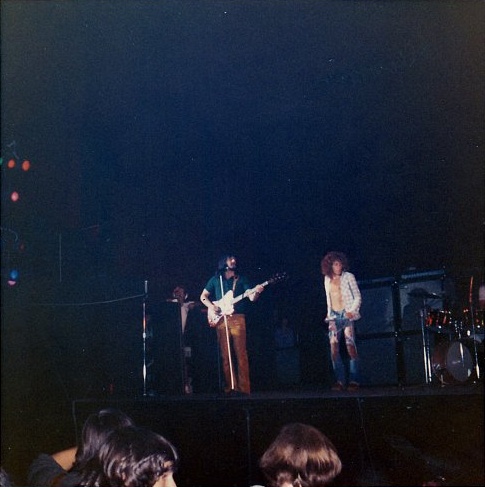
4 or 5 Aug. 1971, Music Hall, Boston, with final use of the WEM PA.
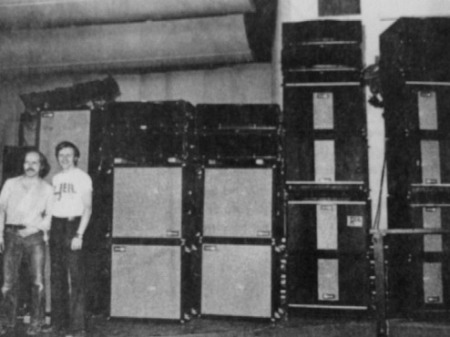
16 Aug. 1971, Edwardsville, Illinois, Bobby Pridden and Bob Heil in front of the new Sunn gear.
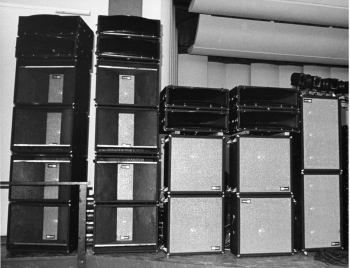
Click to view larger version. 16 Aug. 1971, Edwardsville, Illinois, detail of the new Sunn PA.
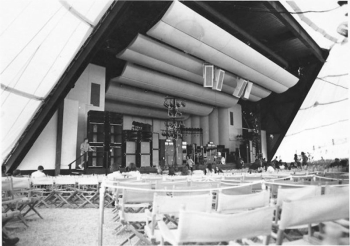
Click to view larger version. 16 Aug. 1971, Edwardsville, Illinois, the new Sunn PA.
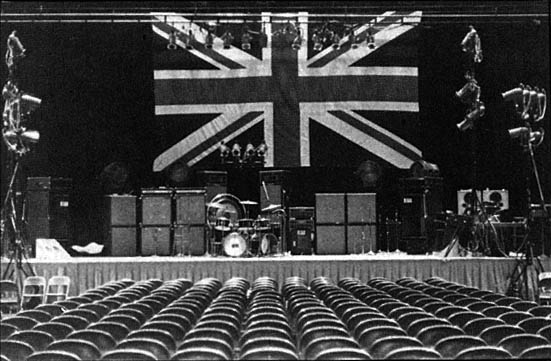
December 1971 stage setup, showing Sunn stageside foldback and two Hiwatt monitor stacks behind the drumkit.
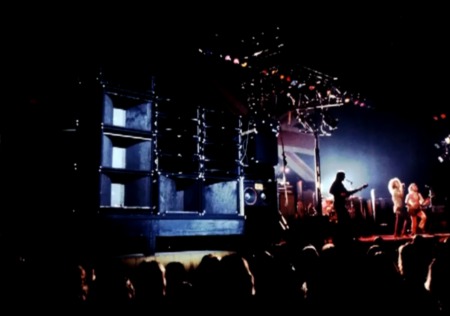
Ca. December 1971, San Francisco, with Sunn PA.
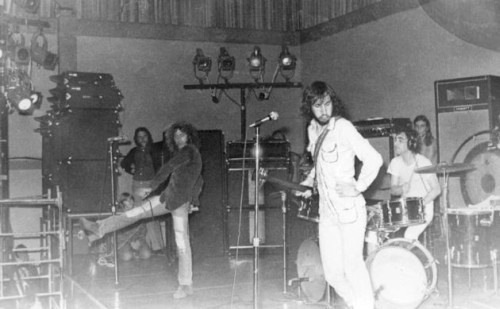
9 Oct. 1971, stage-right view, showing Sunn front-of-house PA stacks, as well as Sunn bin/horn foldback combo closeup angled off the backline (for prerecorded tape playback, and Hiwatt foldback behind the drumkit.
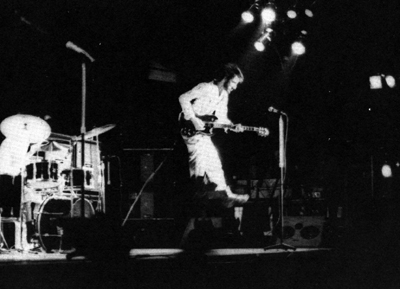
Ca. December 1971, closeup view of stage, with first evidence of the use of a floor wedge visible at stage left. Sunn bin/horn stack at rear of stage next to Pete’s Hiwatt rig for dedicated prerecorded tape playback.
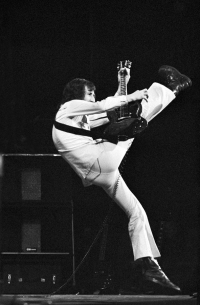
Click to view larger version. Ca. November 1971, Rainbow Theatre, backline Sunn bin/horn stack visible to right of Pete’s Hiwatt rig, for dedicated prerecorded tape playback.
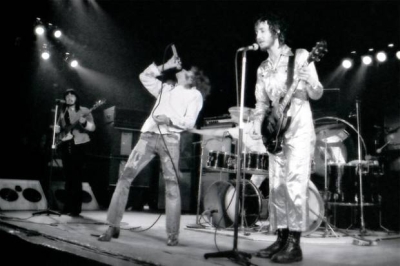
Click to view larger version. Ca. 1971, closeup view of stage, with early evidence of the use of a floor wedges visible at stage right. Sunn bin/horn stack at rear of stage next to John’s Sunn bass rig, for dedicated prerecorded tape playback.
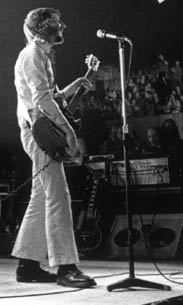
Ca. December 1971, San Francisco, view of stage-right floor wedge. Bobby Pridden looks on from the stage-right mixing board.
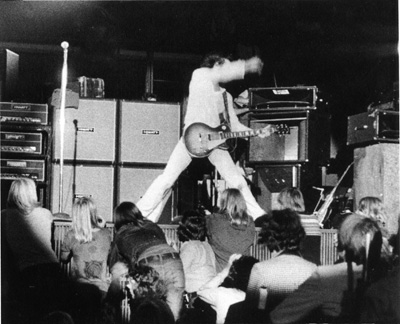
August 1972, sidestage Sunn bin/horn stack visible to right of Pete’s Hiwatt rig. FOH Sunn horn visible at far right.
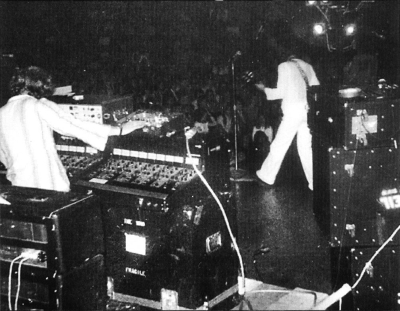
Click to view larger version. 21 Aug. 1972, KB-Hallen, Denmark, two Sunn Coliseum Audio Controller 8-ch. boards for foldback at stage left. At right can be seen Heil stencil on rear of sidestage monitor stack. WEM Copicat for tape echoes visible on top of right-side desk.
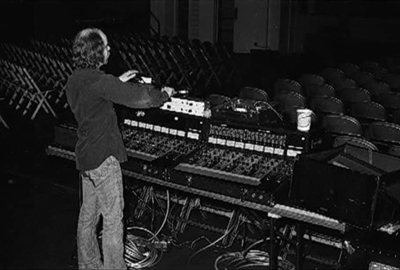
Click to view larger version. Heil front-of-house with two Sunn Coliseum Audio Controller 8-ch. boards. WEM Copicat echo unit for tape echoes visible on top of right-side desk. (Photo: SoundCityChris)
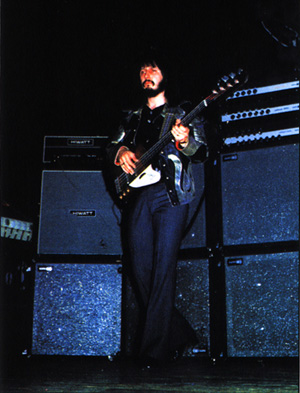
21 Aug. 1972, Kb-Hallen, Denmark, showing Hiwatt/Sunn “foldback” stack topped by Hiwatt CP103 next to John’s rig, for monitoring guitar signal. Portion of rear panel of lighting control board visible at far left.
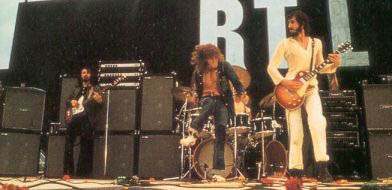
9 Sept., 1972, showing Hiwatt/Sunn “foldback” stack next to John’s rig.
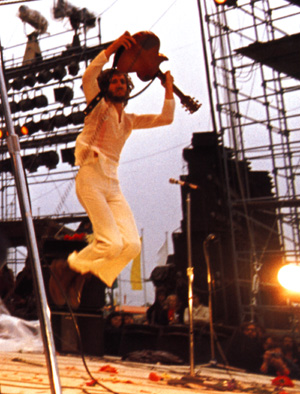
9 Sept., 1972, with three front-of-stage bins apparently set up as tilted foldback at stage-left.
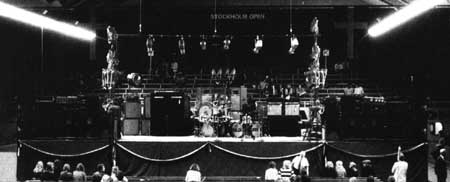
Mid-1972 stage setup, 23 Aug. 1972, Stockholm, Sweden, showing four PA speaker stacks per stageside. (Note: opening act’s gear is set up on stage in front of The Who’s gear.)
Resources and Information
Acknowledgements
- Bob Heil
- Dave Goessling
Special thanks to John Hughes (john@pureneasy.fsnet.co.uk) for assistance with this page.
Sources and related sites:
- Cream amplification: twtd.bluemountains.net.au/cream/amplification.htm (archived)
- Pink Floyd amplification: geocities.com/deadhead20.geo/PFlive.html (archived)
- The Grateful Dead’s “Wall of Sound”: dead.net/cavenweb/deadfile/newsletter19soundrap.html (archived)
- Max The Mod: westminsterinc.com/who1965/equip.htm (offline).
- Rock Hardware: The Instruments, Equipment and Technology of Rock. Edited by Tony Bacon. Harmony Books. 1981.
- The Who Concert File, by Joe McMichael and ‘Irish’ Jack Lyons. Omnibus Press.
- Guitar Player: The Who’s Sound System. How it grew from 200 to 75,000 watts. By Steve Caraway and Tom Wheeler. November 1977.
- repfoto.com.
- Sunn: Unofficial Sunn Museum and The Sunn Shack (archived)
- Watkins Guitar World: watkinsguitars.co.uk
- ML Executives: mlexecutives.org (archived)
Articles
- “Rock hall hails Heil’s wizardry. Metro-east native created equipment for stars.” From the Belleville (Illinois) News-Democrat (archived version), Tuesday, 9 May, 2006
- “Bob Heil: A Living Live-Sound Legend,” from Musician’s Friend (archived), May 2006
- Guitar Player: The Who’s Sound System. How it grew from 200 to 75,000 watts. By Steve Caraway and Tom Wheeler. November 1977.
Manufacturer’s sites
- Watkins Electric Music (WEM): wemwatkins.co.uk
- Bob Heil: heilsound.com
- Marshall Amplification: marshallamps.com
- Vox: voxshowroom.com
- Crown Audio: crownaudio.com
- Showco: showco.com
- Phase Linear History: phaselinearhistory.com
- Shure: shure.com
- Sunn: sunnamps.com
- Revox: revox.ch and reeltoreel.de
- Martin Audio: martin-audio.com
- Midas: midasconsoles.com
